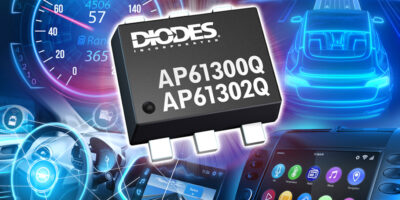Automotive-compliant synchronous buck converters announced by Diodes are intended for high power density automotive designs, for example in vehicle telematics, ADAS, power and infotainment systems and instrumentation clusters.
The AP61300Q and AP61302Q synchronous buck converters are 3A-rated and have a wide input voltage range of 2.4 to 5.5V.
Incorporated into each buck converter is a 70mOhm, high side power MOSFET and a 50mOhm low side power MOSFET. Together, said Diodes, they deliver high efficiency step down DC/DC conversion. They also support fast switching speeds allowing smaller accompanying passives to be specified, reducing the overall bill of materials (BoM) and saving space, confirmed the company.
Depending on the load conditions, the AP61300Q and AP61302Q can be configured to pulse frequency modulation (PFM) or pulse width modulation (PWM) operating modes (using the enable pin). The quiescent current (IQ) of 19 microA, when in PFM mode, allows them to maintain elevated efficiencies even in light load situations. The low drop out (LDO) mode permits output voltage regulation to be maintained when the input voltage comes close to the V out voltage.
The constant on-time (COT) control functionality of both the AP61300Q and AP61302Q feature, rapid transient response, easy loop stabilisation and low output voltage ripple with only minimal external components required. Diodes explained that less PCB area is needed which contributes to a reduction in overall production costs.
The AP61300Q and AP61302Q are supplied in SOT563 packages. Both are AEC-Q100 Grade 1 qualified, PPAP-capable and manufactured in IATF 16949-certified facilities.
Diodes supplies semiconductor products to customers in the consumer electronics, computing, communications, industrial and automotive markets. Its portfolio includes discrete, analogue and mixed-signal products together with packaging technology to meet customers’ needs. The company has a broad range of application-specific products, sales teams and operations in 31 sites around the world, including engineering, testing, manufacturing, and customer services.







